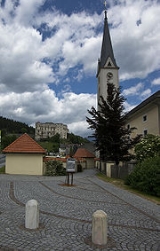
Gmünd
Encyclopedia
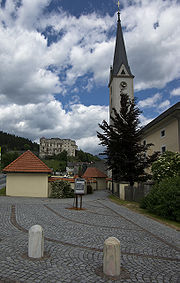
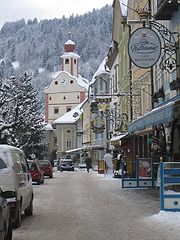
Town
A town is a human settlement larger than a village but smaller than a city. The size a settlement must be in order to be called a "town" varies considerably in different parts of the world, so that, for example, many American "small towns" seem to British people to be no more than villages, while...
in the district of Spittal an der Drau
Spittal an der Drau (district)
The Bezirk Spittal an der Drau is an administrative district in Carinthia, Austria.Area of the district is 2,763.99 km², population is 81,719 , and population density 30 persons per km². It is Austria's second largest district by area...
, in the Austria
Austria
Austria , officially the Republic of Austria , is a landlocked country of roughly 8.4 million people in Central Europe. It is bordered by the Czech Republic and Germany to the north, Slovakia and Hungary to the east, Slovenia and Italy to the south, and Switzerland and Liechtenstein to the...
n state of Carinthia
Carinthia (state)
Carinthia is the southernmost Austrian state or Land. Situated within the Eastern Alps it is chiefly noted for its mountains and lakes.The main language is German. Its regional dialects belong to the Southern Austro-Bavarian group...
.
The municipality is situated within the valley of the Lieser river, a left tributary of the Drava
Drava
Drava or Drave is a river in southern Central Europe, a tributary of the Danube. It sources in Toblach/Dobbiaco, Italy, and flows east through East Tirol and Carinthia in Austria, into Slovenia , and then southeast, passing through Croatia and forming most of the border between Croatia and...
, east of the Hohe Tauern
Hohe Tauern
The Hohe Tauern or High Tauern are a mountain range on the main chain of the Central Eastern Alps, comprising the highest peaks east of the Brenner Pass. The crest forms the southern border of the Austrian state of Salzburg with Carinthia and East Tyrol, while a small part in the southwest belongs...
mountain range.
Municipality breakdown
The municipality is divided into three parts for cadastral, but not for political, purposes: Gmünd, Kreuschlach and Landfrass. There are the following constituent villages (2001 pop. in parentheses):
|
|
History
Once a mansioMansio
In the Roman Empire, a mansio was an official stopping place on a Roman road, or via, maintained by the central government for the use of officials and those on official business whilst travelling.-Background:The roads which traversed the Ancient World, were later surveyed,...
at the Roman road
Roman road
The Roman roads were a vital part of the development of the Roman state, from about 500 BC through the expansion during the Roman Republic and the Roman Empire. Roman roads enabled the Romans to move armies and trade goods and to communicate. The Roman road system spanned more than 400,000 km...
leading to the Katschberg Pass
Katschberg Pass
Katschberg Pass is a high mountain pass in the Central Eastern Alps in Austria between Rennweg am Katschberg in the state of Carinthia and Sankt Michael im Lungau in Salzburg....
and Iuvavum (Salzburg), the town of Gmünd was probably founded by Archbishop Eberhard II of Salzburg
Archbishopric of Salzburg
The Archbishopric of Salzburg was an ecclesiastical State of the Holy Roman Empire, its territory roughly congruent with the present-day Austrian state of Salzburg....
, as it was first documented in 1252. Laid out as a southern outpost of the archbishopric, a market was mentioned in 1273 and Gmünd received town privileges
Town privileges
Town privileges or city rights were important features of European towns during most of the second millennium.Judicially, a town was distinguished from the surrounding land by means of a charter from the ruling monarch that defined its privileges and laws. Common privileges were related to trading...
in 1346.
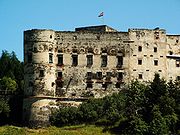
Strategic bombing during World War II
Strategic bombing during World War II is a term which refers to all aerial bombardment of a strategic nature between 1939 and 1945 involving any nations engaged in World War II...
the Porsche
Porsche
Porsche Automobil Holding SE, usually shortened to Porsche SE a Societas Europaea or European Public Company, is a German based holding company with investments in the automotive industry....
vehicle manufacturing company from 1944 on was headquartered in Gmünd until it moved back to the Zuffenhausen
Zuffenhausen
Zuffenhausen is an urban district in the northern suburbs of Stuttgart, the capital of the German state of Baden-Württemberg. It consists mainly of the formerly independent city of Zuffenhausen. The Zuffenhausen district has an area of 1,200 hectares and 35,568 inhabitants .The oldest surviving...
district of Stuttgart
Stuttgart
Stuttgart is the capital of the state of Baden-Württemberg in southern Germany. The sixth-largest city in Germany, Stuttgart has a population of 600,038 while the metropolitan area has a population of 5.3 million ....
in 1950. Here in a former sawmill Ferdinand Porsche
Ferdinand Porsche
Ferdinand Porsche was an Austrian automotive engineer and honorary Doctor of Engineering. He is best known for creating the first hybrid vehicle , the Volkswagen Beetle, and the Mercedes-Benz SS/SSK, as well as the first of many Porsche automobiles...
together with Erwin Komenda
Erwin Komenda
Erwin Komenda ex Dr Ferdinand Porsche employee, helped in the design of the bodies for the VW Beetle and various Porsche sports cars....
designed and built the first Porsche 356
Porsche 356
The Porsche 356 was the company's first production automobile. It was a lightweight and nimble handling rear-engine rear-wheel-drive 2 door sports car available in hardtop coupe and open configurations. Design innovations continued during the years of manufacture, contributing to its motorsports...
sports cars, including the prototype "No.1"
Porsche 356/1
The Porsche 356/1 was the first real Porsche car created by Ferdinand "Ferry" Porsche. This prototype car was a two-seater open roadster with a mid-mounted, air-cooled flat-4 engine of 1,131 cc displacement that produced...
from 1948.
Main sights
Above the old town with the Baroque palace of the Lodron noble family from 1654 are the ruins of Gmünd Castle from the 13th century, destroyed by the troops of Matthias Corvinus of HungaryMatthias Corvinus of Hungary
Matthias Corvinus , also called the Just in folk tales, was King of Hungary and Croatia from 1458, at the age of 14 until his death...
and rebuilt about 1506 under Archbishop Leonhard von Keutschach
Leonhard von Keutschach
Leonhard von Keutschach was Prince-Archbishop of Salzburg from 1495 until his death, the last to rule in the feudal style.- Biography :...
; now it is used for theatrical performances, concerts and lectures.
Near the former Porsche factory, a private museum today shows a choice of historic Porsche cars. This museum has a collection of Porsche 356's, including several rare and very valuable examples.
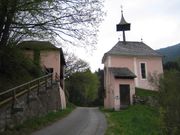
Politics
Seats in the municipal assembly (Gemeinderat) as of 2009 elections:- Alliance for the Future of AustriaAlliance for the Future of AustriaThe Alliance for the Future of Austria , abbreviated to BZÖ, is a conservative liberal political party in Austria. The party has sixteen seats in the National Council....
(BZÖ): 10 - Social Democratic Party of AustriaSocial Democratic Party of AustriaThe Social Democratic Party of Austria is one of the oldest political parties in Austria. The SPÖ is one of the two major parties in Austria, and has ties to trade unions and the Austrian Chamber of Labour. The SPÖ is among the few mainstream European social-democratic parties that have preserved...
(SPÖ): 5 - Austrian People's PartyAustrian People's PartyThe Austrian People's Party is a Christian democratic and conservative political party in Austria. A successor to the Christian Social Party of the late 19th and early 20th centuries, it is similar to the Christian Democratic Union of Germany in terms of ideology...
(ÖVP): 4
Transportation
Gmünd has access to the Tauern AutobahnTauern Autobahn
The Tauern Autobahn is an autobahn in Austria. It starts at the Salzburg junction with the Westautobahn , runs southwards, crosses the Tauern mountain range of the Central Eastern Alps and leads to the Süd Autobahn and Karawanken Autobahn at Villach in Carinthia...
running from Salzburg
Salzburg
-Population development:In 1935, the population significantly increased when Salzburg absorbed adjacent municipalities. After World War II, numerous refugees found a new home in the city. New residential space was created for American soldiers of the postwar Occupation, and could be used for...
to Villach
Villach
Villach is the second largest city in the Carinthia state in the southern Austria, at the Drava River and represents an important traffic junction for Austria and the whole Alpe-Adria region. , the population is 58,480.-History:...
. The nearest train station is at the Tauernbahn railway line in Spittal an der Drau
Spittal an der Drau
Spittal an der Drau is located in the western part of the Austrian federal state of Carinthia and the administrative centre of the federal state's second largest district, Spittal an der Drau. It lies between the Lurnfeld area and the Lower Drava Valley. The city consists of the seven...
.
Twin towns — Sister cities
Gmünd is twinnedTown twinning
Twin towns and sister cities are two of many terms used to describe the cooperative agreements between towns, cities, and even counties in geographically and politically distinct areas to promote cultural and commercial ties.- Terminology :...
with: Osnabrück
Osnabrück
Osnabrück is a city in Lower Saxony, Germany, some 80 km NNE of Dortmund, 45 km NE of Münster, and some 100 km due west of Hanover. It lies in a valley penned between the Wiehen Hills and the northern tip of the Teutoburg Forest...
, Germany
Germany
Germany , officially the Federal Republic of Germany , is a federal parliamentary republic in Europe. The country consists of 16 states while the capital and largest city is Berlin. Germany covers an area of 357,021 km2 and has a largely temperate seasonal climate...
since 1971
External links
- Official website
- Porsche Automuseum Helmut Pfeifhofer
- "Visita al museo Porsche a Gmund, in Carinzia" by Fulvio Gubiani

